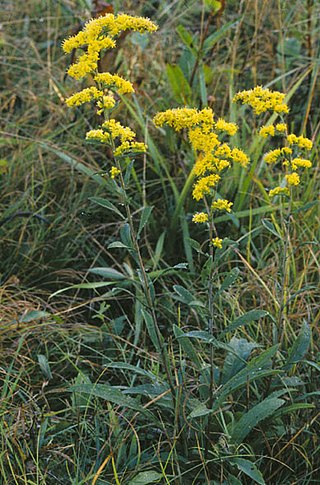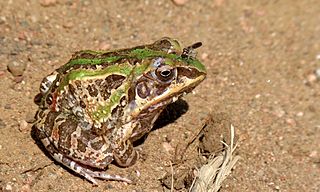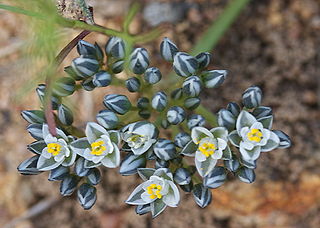
Mentha is a genus of flowering plants in the family Lamiaceae. It is estimated that 13 to 24 species exist, but the exact distinction between species is unclear. Hybridization occurs naturally where some species' ranges overlap. Many hybrids and cultivars are known.

Goldenrod is a common name for many species of flowering plants in the sunflower family, Asteraceae, commonly in reference to the genus Solidago.

Stipa is a genus of around 300 large perennial hermaphroditic grasses collectively known as feather grass, needle grass, and spear grass. They are placed in the subfamily Pooideae and the tribe Stipeae, which also contains many species formerly assigned to Stipa, which have since been reclassified into new genera.

Joseph Marie Henry Alfred Perrier de la Bâthie was a French botanist who specialized in the plants of Madagascar.

Linaceae is a family of flowering plants. The family is cosmopolitan, and includes about 250 species in 14 genera, classified into two subfamilies: the Linoideae and Hugonioideae. Leaves of the Linaceae are always simple; arrangement varies from alternate to opposite or whorled. The hermaphroditic, actinomorphic flowers are pentameric or, very rarely, tetrameric.

Amomum is a genus of plants containing about 111 species native to China, the Indian subcontinent, Southeast Asia, New Guinea, and Queensland. It includes several species of cardamom. Plants of this genus are remarkable for their pungency and aromatic properties.

Selenicereus, sometimes known as moonlight cactus, is a genus of epiphytic, lithophytic, and terrestrial cacti, found in Mexico, Central America, the Caribbean and northern South America. The term night-blooming cereus is also sometimes used, but this is also used for many night-blooming cacti, including Epiphyllum and Peniocereus. In 2017, the genus Hylocereus was brought into synonymy with Selenicereus. A number of species of Selenicereus produce fruit that is eaten. The fruit, known as pitaya or pitahaya in Spanish or as dragon fruit, may be collected from the wild or the plants may be cultivated.

Hildebrandtia is a genus of frogs in the family Ptychadenidae. They are distributed in tropical and subtropical Sub-Saharan Africa. The common name of this genus is Hildebrandt's burrowing frogs or ornate frogs. The genus name honours Johann Maria Hildebrandt, a German botanist and explorer.
Hildebrandtia may refer to:

Clinostigma is a genus of flowering plants in the Arecaceae (palm) family. It is native to various islands in the western Pacific.

I. M. Johnston, was a United States botanist. He studied at Pomona College in Claremont, California and at Harvard University. His plant collections are housed in the Rancho Santa Ana Botanic Garden, in Claremont, and also in the Gray Herbarium of Harvard University.

Ludwig Adolph Timotheus Radlkofer, was a Bavarian taxonomist and botanist.
Conrad Vernon Morton was an American botanist, who did notable writings on ferns. He was also a specialist in Gesneriaceae and Solanaceae for the Smithsonian Institution from 1928.

Hans Schinz was a Swiss explorer and botanist who was a native of Zürich.

Lumnitzera is an Indo-West Pacific mangrove genus in the family Combretaceae. An English common name is black mangrove. Lumnitzera, named after the German botanist, Stephan Lumnitzer (1750-1806), occurs in mangroves from East Africa to the Western Pacific, and northern Australia.

Limeum is a genus of flowering plants. It includes 25 species.

The World Checklist of Selected Plant Families was an "international collaborative programme that provides the latest peer reviewed and published opinions on the accepted scientific names and synonyms of selected plant families." Maintained by the Royal Botanic Gardens, Kew, it was available online, allowing searches for the names of families, genera and species, as well as the ability to create checklists.
Manjekia is a monotypic genus of palm for a species of palm native to Biak island, Indonesia, off the northwest coast of New Guinea. The genus was proposed in 2014.
Jailoloa is a genus of palm, in the subtribe Ptychospermatinae. It has only one currently accepted species, Jailoloa halmaherensis, native to the Moluccas. It only grows on ultramafic soils. The species is currently known only from its type locality in East Halmahera.
Wallaceodoxa is a genus of palm, in the subtribe Ptychospermatinae. It has only one currently accepted species, Wallaceodoxa raja-ampat, native to the Raja Ampat Islands off the Bird's Head Peninsula of New Guinea. It grows on limestone soils.














